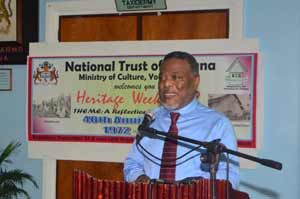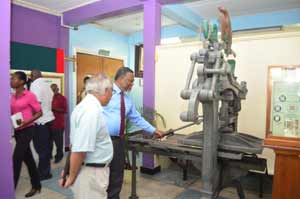THE National Trust, for its 40th anniversary, hosted an exhibition yesterday under the theme ‘A reflection of Heritage’.
 It is a part of Heritage Month celebrations and the showing will continue through October 5 at the National Museum, Company Path, in Georgetown, where various historic and traditional exhibits, dating back hundreds of years in Guyana’s history, are on display.
It is a part of Heritage Month celebrations and the showing will continue through October 5 at the National Museum, Company Path, in Georgetown, where various historic and traditional exhibits, dating back hundreds of years in Guyana’s history, are on display.
Prime Minister Samuel Hinds, performing the functions of the Office of President, graced the event and commended the host for such an initiative.
He said Guyana is not a very rich country but it has come far and has done a lot with the little it possesses.
Mr. Hinds recalled his childhood days and remembered that, during his examinations in school, most of the questions were based on the country’s heritage and its traditions.
He said it is good that the Trust has recognised achievements of foreparents and thought it fitting to have such an exhibition.
Meanwhile, Minister of Culture, Youth and Sport, Dr. Frank Anthony, who also spoke on the occasion, said more focus will be placed on intangible national heritage in Guyana.
“Apart from the tangible heritage we often speak about, we need to place more focus on intangible heritage, too. I think we have to focus on this more. I know we have done a lot of work on this but I think more can be done,” he posited.
Very unique Anthony said that, as a country, Guyana is rich in terms of its heritage and very unique as compared to many other countries.
Anthony said that, as a country, Guyana is rich in terms of its heritage and very unique as compared to many other countries.
“In terms of the intangible heritage we enjoy as a country, I think we are quite unique because, as a country with several different Amerindian languages, it is very different from many countries,” he maintained.
Guyana owns nine different Amerindian languages and, according to the minster, with the work and help of various partners, five dictionaries of them were developed.
Alluding to the nine Amerindian languages in Guyana, the Minister said, if more focus is not placed on them, they will, eventually, fade away in society.
He said many of the Amerindian languages, because they are not being properly preserved, have been listed among the United Nations Educational Scientific and Cultural Organisation’s (UNESCO’s) endangered.
Anthony said, over the years, the National Trust would have contributed significantly to the preservation and conservation of Guyana’s rich heritage.
He thanked Director of Culture, Dr. James Rose, for his support throughout the years and said, under his leadership, the Trust has accomplished a lot.
Anthony said, for forty years now, the Trust has been focused on traditions and views on what is termed heritage.
He identified the works that have been done to the various forts and other historical sites in Guyana which have now given every generation till now an opportunity to journey back in time during those periods of history.
The Minister said, with the establishment of the Dutch Heritage Museum, it would have added another dimension to Guyanese heritage and tradition.
“We also looked at various periods of our history and I think that, while we have done some work, there is still a lot that needs to be done in those areas,” Anthony stated.
Complete documentation He said the various organisations have been working along with the Ministry and have been doing works in terms of Amerindian Heritage, over the last few years. However, more is yet to be done to have a complete documentation.
He said the various organisations have been working along with the Ministry and have been doing works in terms of Amerindian Heritage, over the last few years. However, more is yet to be done to have a complete documentation.
“We have been doing works, in terms of our Amerindian Heritage going back and trying to find out a little bit more about what it used to be before colonial times and some of the works that we are doing have been completed …we have lots of documentation,” he reported.
Anthony said, in the last two to three years, much focus has been and continues to be placed on the Berbice River and, with the help of a number of researchers from the United States (U.S.), discoveries have been made about indigenous life along the river.
“We are now discovering that, apparently, there were significant Amerindians or indigenous civilisation that lived along the Berbice River and we can also say, from the preliminary results, that it was quite an ancient civilisation and it was like somewhere before 3000 years B.C.,” he suggested.
He admitted that a lot more research will need to be done in that area and said, already, there are indications that a number of universities would come into Guyana and assist in this regard.
Anthony said the National Trust will need to pay keen attention to this area, not only because it is Guyana’s Amerindian Heritage but also the National Heritage and this is very important to a country.



.jpg)









